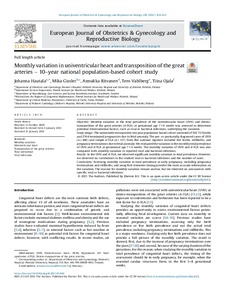Monthly variation in univentricular heart and transposition of the great arteries-10-year national population-based cohort study
Hautala Johanna; Gissler Mika; Ritvanen Annukka; Vahlberg Tero; Ojala Tiina
Monthly variation in univentricular heart and transposition of the great arteries-10-year national population-based cohort study
Hautala Johanna
Gissler Mika
Ritvanen Annukka
Vahlberg Tero
Ojala Tiina
ELSEVIER
Julkaisun pysyvä osoite on:
https://urn.fi/URN:NBN:fi-fe2021042821483
https://urn.fi/URN:NBN:fi-fe2021042821483
Tiivistelmä
Objective: Monthly variation in the total prevalence of the univentricular heart (UVH) and dextro-transposition of the great arteries (d-TGA) at gestational age 7 + 0 weeks was assessed to determine potential environmental factors, such as viral or bacterial infections, underlying the variation.Study design: The nationwide retrospective ten-year population-based cohort consisted of 592 733 births and 2764 terminated pregnancies due to fetal anomaly. The pre- or postnatally diagnosed cases of UVH (n = 440) and simple d-TGA (n = 127) from five national registers included live births, stillbirths, and pregnancy terminations due to fetal anomaly. We evaluated the variation in the monthly total prevalence of UVH and d-TGA at gestational age 7 + 0 weeks. The monthly variation of UVH and d-TGA was also compared with monthly variation in reported viral and bacterial infections.Results: In the UVH and d-TGA, we observed significant monthly variation in total prevalence. However, we observed no correlations in the studied viral or bacterial infections and the number of cases.Conclusions: Assessing monthly variation in total prevalence at early pregnancy, including pregnancy terminations and stillbirths, and using first-trimester timing provides the most accurate information on the variation. The reasons for monthly variation remain unclear, but we observed no associations with specific viral or bacterial infections. (C) 2021 Elsevier B.V. All rights reserved.
Kokoelmat
- Rinnakkaistallenteet [27094]
